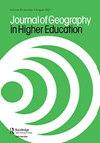Editorial: they think it’s all over…
IF 1
4区 教育学
Q2 EDUCATION & EDUCATIONAL RESEARCH
引用次数: 0
Abstract
They think it’s all over. Revellers welcome in the New Year 2023 in TV pictures from cities around the globe, no vestige of social distancing apparent. The intermission concluded, normal service resumed. For those of us working in transnational education in China, the interregnum of COVID-19 restrictions lasted longer than anywhere before an abrupt change in policy. The challenge of the rapid pivot to online learning was handled admirably in the circumstances, but now the pivot back to in-person teaching may be equally challenging. They think it’s all over. Back to the classroom. They think it’s all over. What have we, as educators, experienced and learnt from the hiatus? Exasperation or inspiration? Disconnection or reinvention? Disturbance or innovation? Hollowness or thoughtfulness? The pages of pedagogic journals attest to ingenuity, ambition and imagination of educators responding to the difficult challenges of a global pandemic, burgeoning in-trays of journal editors in the process. Across academia, a Web of Science search indicates that over 360,000 journal articles referring to COVID-19 had been published by the end of 2022. Unsurprisingly, over 80,000 contributions are catalogued as virology with two early papers on the clinical characteristics of the new virus accumulating more than 10,000 citations each. More than 200 articles exceed 1,000 citations. Just 2% of these papers are in journals classified as education and educational research, but 22,854 papers refer to COVID-19 and Higher Education. Refining the search to COVID-19 and Higher Education and Geography, 163 papers have been published by end 2022 with more than a quarter of these specifically relating to teaching and learning in a university context. They think it’s all over. Might the melodrama of managing a journal through the pandemic give way to a period of calm? The challenges, particularly in the earlier phases of the pandemic, created a triple whammy. First, perhaps finding the initial interruption to normal academic life an opportunity to reflect and write about interventions and observations in geography education, we experienced a surge in submission rate, 50% above pre-pandemic traffic. Second, the difficulties of recruiting willing referees, for several years a worrying trend, further exacerbated, necessitating additional work from the editorial board to secure peer reviews. Third, as many of our editorial board members, by the nature of their expertise and experience, were first responders for quality assurance and digital transformation of curricula in their respective schools and institutions, capacity for editorial duties was squeezed. Inevitably, a few submissions to the journal have been snagged by delays in the review system resulting in a less than satisfactory experience for some authors. However, it is testament to the dedication and diligence of the editorial board and peer reviewers that the majority of submissions have progressed. A pre-pandemic tradition is here reinstated that this editorial serves as a prelude to list of referees who have provided reviews in the 2020-22 period. JOURNAL OF GEOGRAPHY IN HIGHER EDUCATION 2023, VOL. 47, NO. 1, 1–8 https://doi.org/10.1080/03098265.2023.2168862社论:他们认为一切都结束了……
他们认为一切都结束了。2023年新年,狂欢者在全球城市的电视画面中受到欢迎,没有明显的社交距离痕迹。中场休息结束,恢复正常服务。对于我们这些在中国从事跨国教育工作的人来说,新冠肺炎限制措施的过渡期比政策突然改变之前的任何时候都要长。在这种情况下,快速转向在线学习的挑战得到了令人钦佩的处理,但现在转向面对面教学可能同样具有挑战性。他们认为一切都结束了。回到教室。他们认为一切都结束了。作为教育工作者,我们从中断中经历了什么,学到了什么?愤怒还是灵感?断开连接还是重新发明?干扰还是创新?空虚还是深思熟虑?教育学期刊的页面证明了教育工作者在应对全球疫情的艰难挑战时的独创性、雄心和想象力,在这一过程中,期刊编辑们如鱼得水。在整个学术界,科学网的搜索显示,截至2022年底,已有超过36万篇涉及新冠肺炎的期刊文章发表。不出所料,超过80000篇文章被归类为病毒学,两篇关于新病毒临床特征的早期论文各被引用超过10000次。200多篇文章引用次数超过1000次。这些论文中只有2%发表在分类为教育和教育研究的期刊上,但22854篇论文涉及新冠肺炎和高等教育。通过对新冠肺炎、高等教育和地理的搜索,截至2022年底,已发表163篇论文,其中四分之一以上专门涉及大学背景下的教学。他们认为一切都结束了。在疫情期间管理期刊的情节剧会让位于平静期吗?这些挑战,特别是在疫情早期阶段,造成了三重打击。首先,也许我们发现正常学术生活的最初中断是一个反思和写作地理教育干预和观察的机会,我们的提交率激增,比疫情前的流量高出50%。第二,招募有意愿的裁判的困难,几年来一直是一个令人担忧的趋势,进一步加剧了这一困难,编辑委员会必须做更多的工作来确保同行评审。第三,由于我们的许多编委会成员凭借其专业知识和经验,是各自学校和机构课程质量保证和数字化转型的第一反应者,因此编辑职责的能力受到了挤压。不可避免的是,一些提交给该杂志的稿件因审查系统的延迟而受阻,导致一些作者的体验不太令人满意。然而,大多数投稿都取得了进展,这证明了编委会和同行评审员的奉献精神和勤奋。这里恢复了疫情前的传统,即这篇社论是2020-22年期间提供审查的裁判名单的前奏。《高等教育地理杂志2023》,第47卷,第1期,1-8页https://doi.org/10.1080/03098265.2023.2168862
本文章由计算机程序翻译,如有差异,请以英文原文为准。
求助全文
约1分钟内获得全文
求助全文
来源期刊

Journal of Geography in Higher Education
Multiple-
CiteScore
5.80
自引率
9.50%
发文量
29
期刊介绍:
The Journal of Geography in Higher Education ( JGHE) was founded upon the conviction that the development of learning and teaching was vitally important to higher education. It is committed to promote, enhance and share geography learning and teaching in all institutions of higher education throughout the world, and provides a forum for geographers and others, regardless of their specialisms, to discuss common educational interests, to present the results of educational research, and to advocate new ideas.
 求助内容:
求助内容: 应助结果提醒方式:
应助结果提醒方式:


